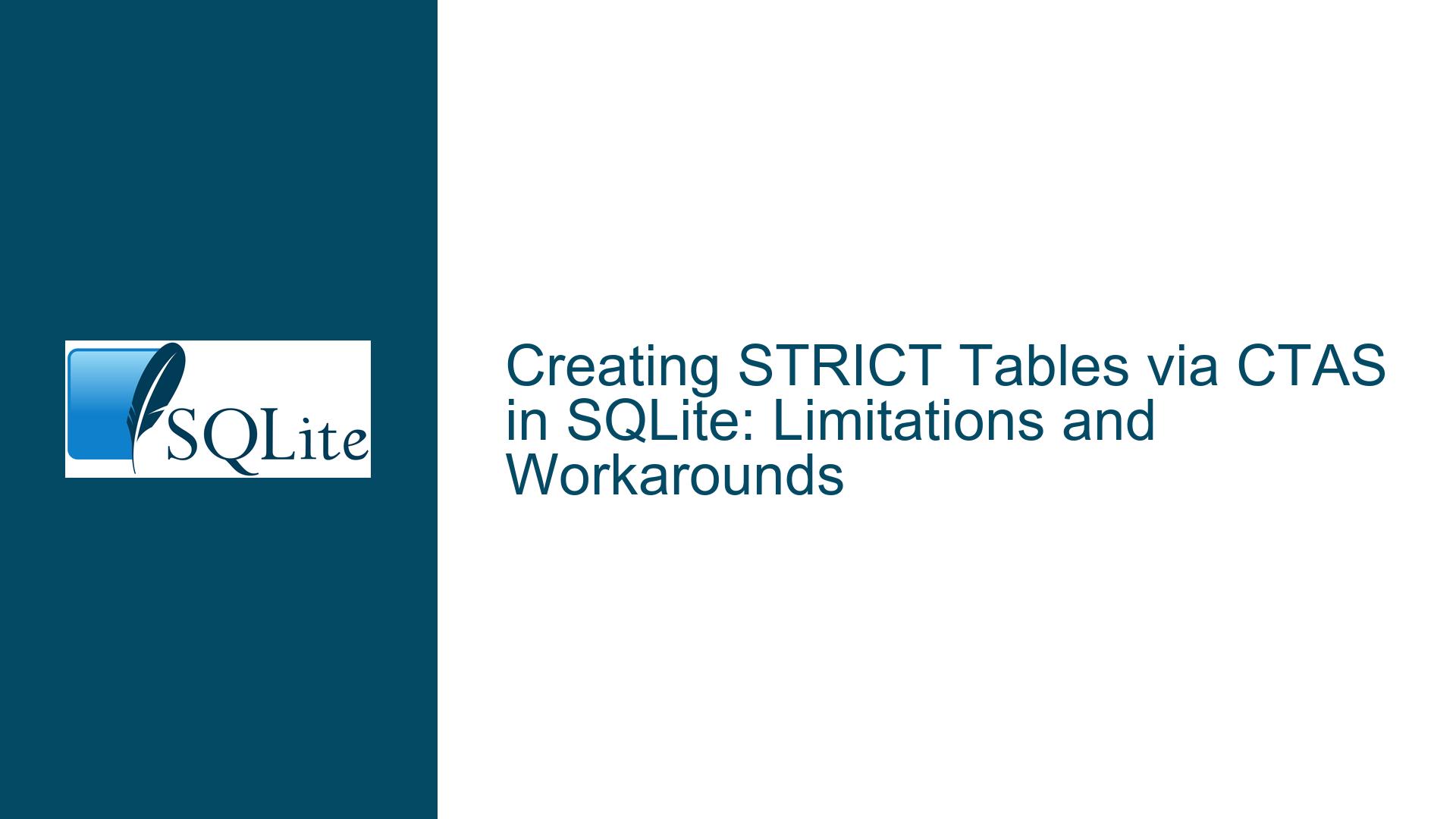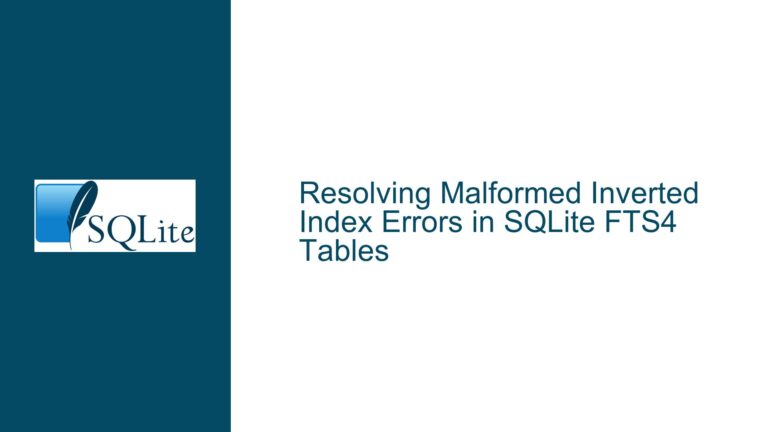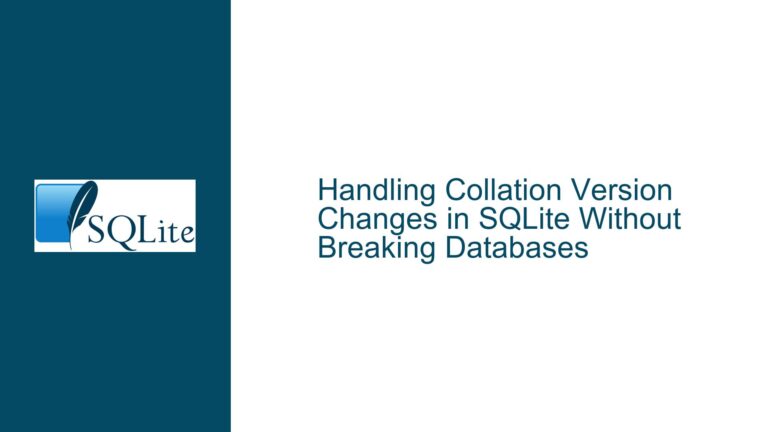Creating STRICT Tables via CTAS in SQLite: Limitations and Workarounds
Understanding STRICT Table Creation Challenges with CREATE TABLE AS SELECT
The core challenge revolves around attempting to create a STRICT table in SQLite using the CREATE TABLE ... AS SELECT (CTAS) syntax. When using CTAS, SQLite automatically infers column names and data types based on the result set of the SELECT statement. However, the resulting table does not inherit the STRICT table modifier, even if the data types in the SELECT clause appear to align with SQLite’s type system. This leads to a table with dynamic typing behavior instead of the enforced column-level type constraints provided by STRICT tables.
For example, executing the following statement:
CREATE TABLE myTBL AS SELECT 'SQLite' AS Origin, datetime() AS Created, 1000 AS Price;
produces a table with the schema:
CREATE TABLE myTBL(Origin, Created, Price);
This table lacks the STRICT keyword and does not enforce column data types. Consequently, inserting values of incompatible types (e.g., a string into the Price column) will not generate errors, which defeats the purpose of using a STRICT table.
The problem extends to the absence of mechanisms to retroactively convert a non-STRICT table to a STRICT table using ALTER TABLE. SQLite’s ALTER TABLE command does not support modifying a table’s strictness or redefining column types to enforce strict affinity. This creates a scenario where developers must choose between the convenience of CTAS and the data integrity guarantees of STRICT tables.
Why SQLite’s CTAS Syntax and STRICT Tables Are Incompatible
The inability to create a STRICT table directly via CTAS stems from three interrelated factors:
1. Syntax Limitations of CTAS:
The CREATE TABLE ... AS SELECT syntax does not support additional table modifiers like STRICT. The CTAS operation is designed to create a table with columns that mirror the result set of the SELECT query, but it does not allow specifying table-level constraints or modifiers during creation. This is a deliberate design choice in SQLite to keep CTAS simple and focused on schema inference.
2. Column Type Inference in CTAS:
When using CTAS, SQLite assigns column affinities based on the expressions in the SELECT clause. For instance, the expression 1000 AS Price results in a column with INTEGER affinity. However, affinities in standard SQLite tables are not strict; they merely influence how values are stored. STRICT tables, introduced in SQLite 3.37.0 (2021-11-27), enforce exact type checking. The CTAS mechanism predates STRICT tables and does not integrate with this newer feature.
3. ALTER TABLE Restrictions:
SQLite’s ALTER TABLE command has limited functionality. It cannot add the STRICT modifier to an existing table or redefine column types to enforce strict typing. For example, attempting ALTER TABLE myTBL STRICT; or ALTER TABLE myTBL MODIFY COLUMN Price INTEGER STRICT; will fail. This limitation forces developers to define strictness at the time of table creation, which conflicts with the CTAS workflow.
Implementing STRICT Tables Without CTAS: Solutions and Alternatives
To work around the CTAS limitation, developers must explicitly define the table schema with the STRICT modifier before inserting data. Below are detailed steps and considerations for achieving this:
1. Explicit Schema Definition with STRICT:
Define the table structure upfront, specifying column types and the STRICT keyword. This ensures type enforcement from the outset.
CREATE TABLE myTBL (
Origin TEXT,
Created DATETIME,
Price INTEGER
) STRICT;
After creating the table, populate it using an INSERT INTO ... SELECT statement:
INSERT INTO myTBL (Origin, Created, Price)
SELECT 'SQLite', datetime(), 1000;
This two-step approach guarantees strict typing while achieving the same outcome as CTAS.
2. Programmatic Schema Generation:
If the column names and types from the SELECT query are known, automate the generation of the CREATE TABLE statement. For example, using a scripting language or SQLite’s command-line shell:
# Generate CREATE TABLE statement with STRICT
echo "CREATE TABLE myTBL (Origin TEXT, Created DATETIME, Price INTEGER) STRICT;" | sqlite3 db.sqlite
# Insert data via SELECT
echo "INSERT INTO myTBL SELECT 'SQLite', datetime(), 1000;" | sqlite3 db.sqlite
This method preserves strictness while minimizing manual effort.
3. Transactional Wrapping for Atomicity:
To mimic the atomicity of CTAS (which creates and populates the table in a single operation), wrap the explicit CREATE TABLE and INSERT statements in a transaction:
BEGIN TRANSACTION;
CREATE TABLE myTBL (
Origin TEXT,
Created DATETIME,
Price INTEGER
) STRICT;
INSERT INTO myTBL (Origin, Created, Price)
SELECT 'SQLite', datetime(), 1000;
COMMIT;
This ensures that either both operations succeed or neither is applied, maintaining database consistency.
4. Future-Proofing with SQLite Version Monitoring:
As of SQLite 3.44.0 (2023-11-01), there is no built-in support for altering tables to become STRICT or using CTAS with STRICT. However, monitoring SQLite’s release notes is critical. Future versions may introduce syntax like CREATE STRICT TABLE ... AS SELECT or ALTER TABLE ... STRICT. Subscribe to SQLite’s changelog and update your workflows accordingly.
5. Schema Validation Triggers (Fallback):
If strict typing is required but upgrading SQLite is not feasible, create triggers to enforce type checks:
CREATE TRIGGER validate_myTBL_Origin
BEFORE INSERT ON myTBL
BEGIN
SELECT RAISE(ABORT, 'Invalid Origin type')
WHERE typeof(NEW.Origin) != 'text';
END;
CREATE TRIGGER validate_myTBL_Created
BEFORE INSERT ON myTBL
BEGIN
SELECT RAISE(ABORT, 'Invalid Created type')
WHERE typeof(NEW.Created) NOT IN ('text', 'integer');
END;
CREATE TRIGGER validate_myTBL_Price
BEFORE INSERT ON myTBL
BEGIN
SELECT RAISE(ABORT, 'Invalid Price type')
WHERE typeof(NEW.Price) != 'integer';
END;
This approach mimics strict typing but adds overhead and complexity compared to native STRICT tables.
By adopting these strategies, developers can enforce strict typing in SQLite while accommodating the current limitations of CTAS and ALTER TABLE.






